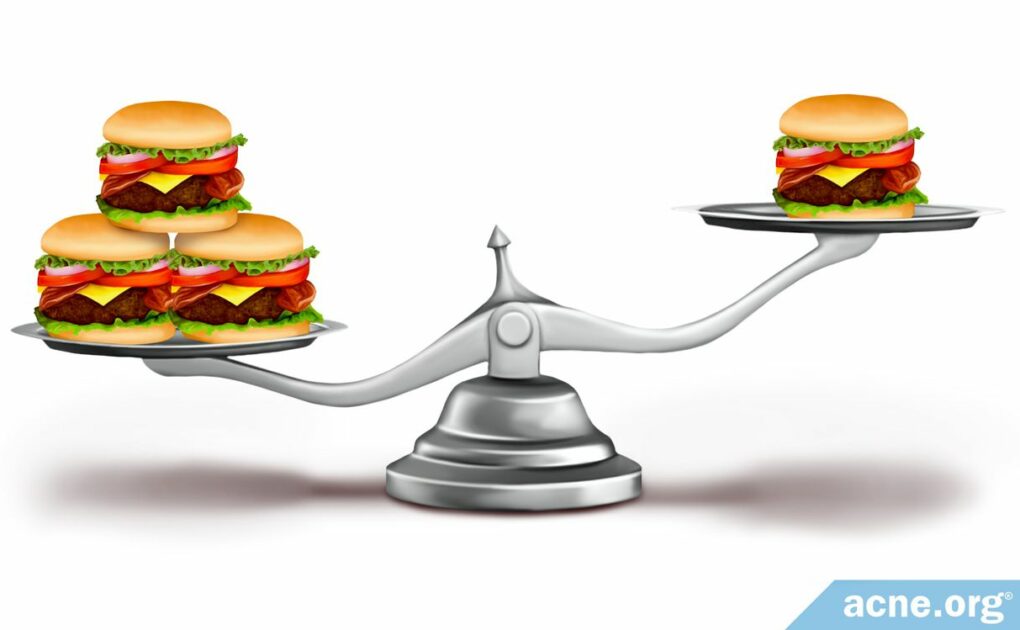Avoiding Consistent Overeating May Help Reduce Hormone Spikes and Resulting Acne Breakouts

The Essential Info
Many “anti-acne diets” seem to work only temporarily. Why is this the case? It may come down to calories. Decreasing calories may help balance hormones and clear acne in the short term. So that “anti-acne diet” you were on might have worked at first because removing “bad” foods really just meant you lowered calories.
We can’t continually lower calories because this would of course lead to starvation and death. So, a more sustainable way to eat that can help keep your hormone levels in check is to consume low glycemic (low sugar), whole, unprocessed foods alongside colorful fruits and vegetables whenever you can. In other words, eat healthy to support your skin instead of chasing that miracle “anti-acne diet.”
How to Use This Tool in Your Arsenal: If a significant event like the prom or your class photo is coming up in a week or so, feel free to anticipate it by lowering your calories a bit until the event arrives. This might help you look clearer. But don’t get carried away with it, and don’t rely on this trick to stay clear on an ongoing basis. It will only work once in a while.

The Science
- Calories –> Insulin Hormones –> More Skin Oil Production –> Acne
- Extreme Low-calorie Diets Result in Less Skin Oil Production
- So What Should We Make of This?
There is a growing body of scientific evidence to support the idea that diet and acne may be, at least in part, connected. Perhaps the most overlooked dietary factor that may affect acne development is caloric intake.
Research has shown that a high calorie diet may increase hormones that are associated with acne. On the flip side, lowering calories might have the opposite effect.
This could be why so many “anti-acne diets” seem to work in the short term. Eliminating foods that are “bad” for acne may simply end up decreasing overall calorie intake.
Scientists are currently delving into this topic and publishing more information, so we can’t say anything concrete yet, but let’s have a look at how calories affect hormones in the body, specifically insulin, and how this might be associated with acne.
Warning: Deep science ahead! (but it’s kinda interesting actually)
Calories –> Insulin Hormones –> More Skin Oil Production –> Acne
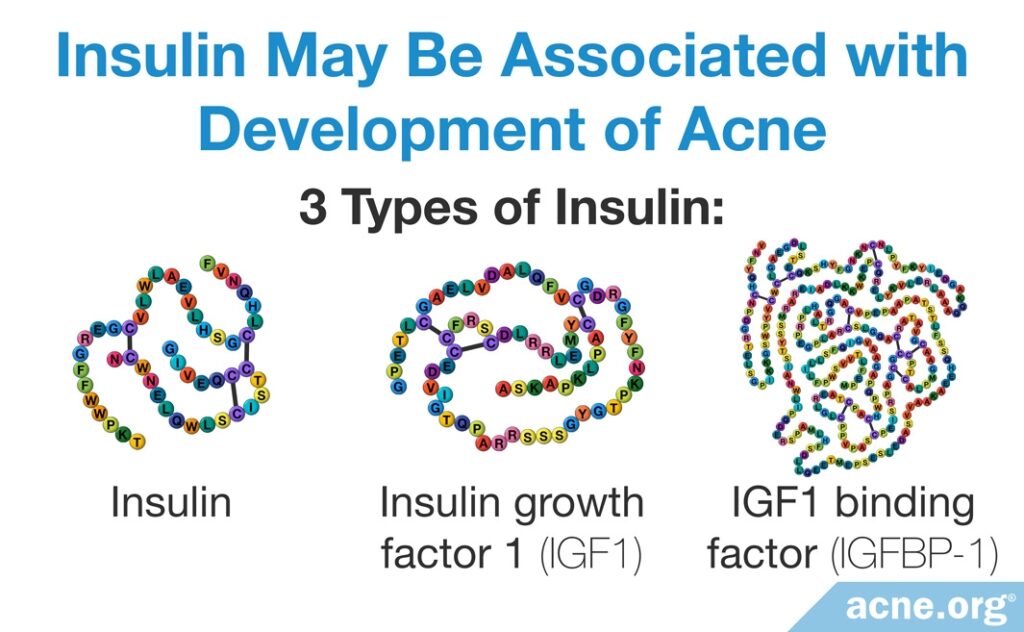
The following insulin hormones get elevated when we eat–particularly when we eat carbohydrates:
- Insulin
- Insulin growth factor 1 (IGF-1)
- IGF-1 binding factor (IGFBP-1)
These insulin hormones in turn may affect the following two proteins:
- FoxO1 – suppresses skin oil production
- mTORC1 – promotes skin oil production
Here is a simplified version of how this might happen: Researchers have found insulin hormones act by decreasing the amount of FoxO1 and increasing the amount of mTORC1 in the body. When FoxO1 levels are decreased and mTORC1 levels are increased, this leads to an increase in skin oil (sebum) production.1-5 Generally speaking, more sebum means more acne. So, a high calorie diet may push this process into overdrive, leading to a large increase in sebum, and voila, more acne.
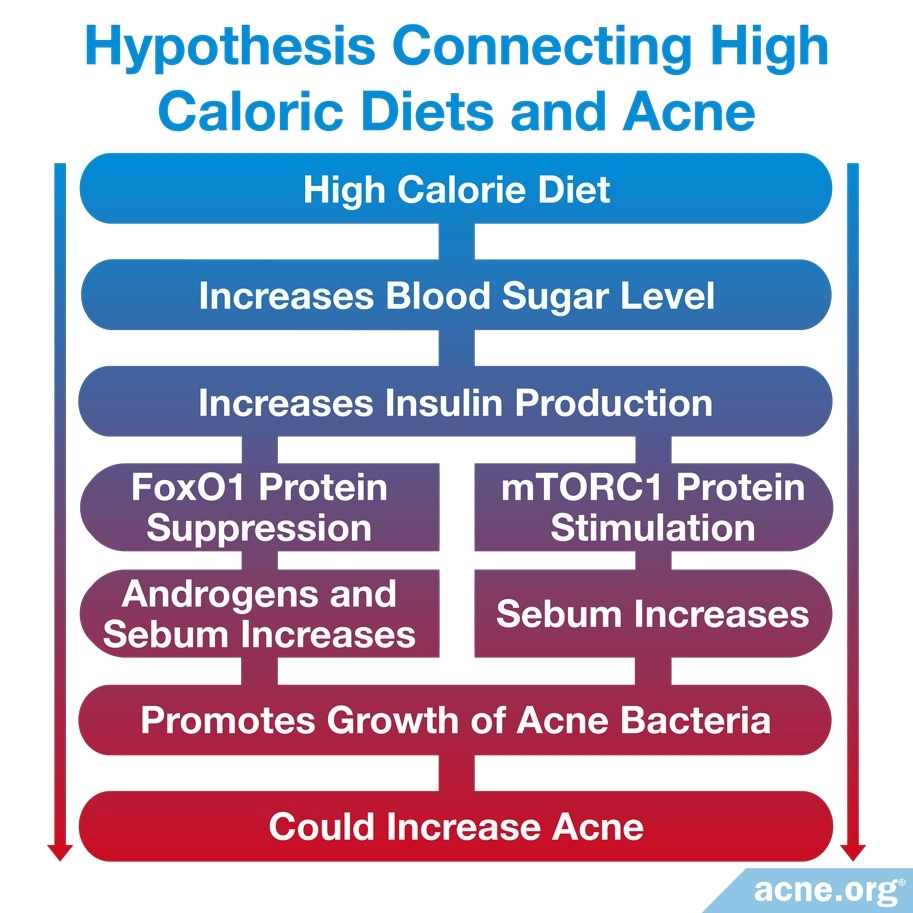
Extreme Low-calorie Diets Result in Less Skin Oil Production
The opposite may also be true. A low-calorie diet may decrease sebum production. Two studies done in 1970 and 1972 showed that severe caloric restriction decreased skin oil secretion dramatically.6,7
Expand to read details of studies
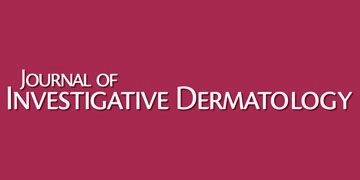
The first study, performed in 1970, looked at the response of the sebaceous (skin oil-producing) glands to caloric restriction in 18 overweight patients for 4 to 8 weeks. They found an average decrease of sebum production by 40%.6
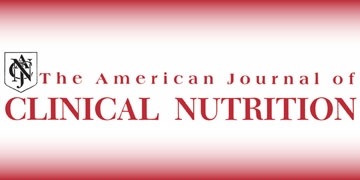
The second study, performed in 1972, followed 4 patients who fasted for 10 days. After 5 days of fasting, all fats in the skin oil on the forehead were reduced, except for a type of fat called squalene. When normal diet was resumed, the change reversed.7
So What Should We Make of This?
Some evidence is showing us that eating a high-calorie diet, particularly eating a lot of high glycemic (high sugar) foods, might lead to more acne.8,9
On the flip side, reducing calories might lead to less acne.
However, it’s impossible to stick to a low-calorie diet in the long term and stay fueled and healthy. Therefore, rather than trying to use caloric restriction to limit acne, try eating sensible portions of nutritious, low glycemic foods when you can instead.10,11 In short, don’t obsess over calories. Instead, try to become more aware of what you are eating and make better choices. Think “whole foods” and “unprocessed” and you are more than halfway there.
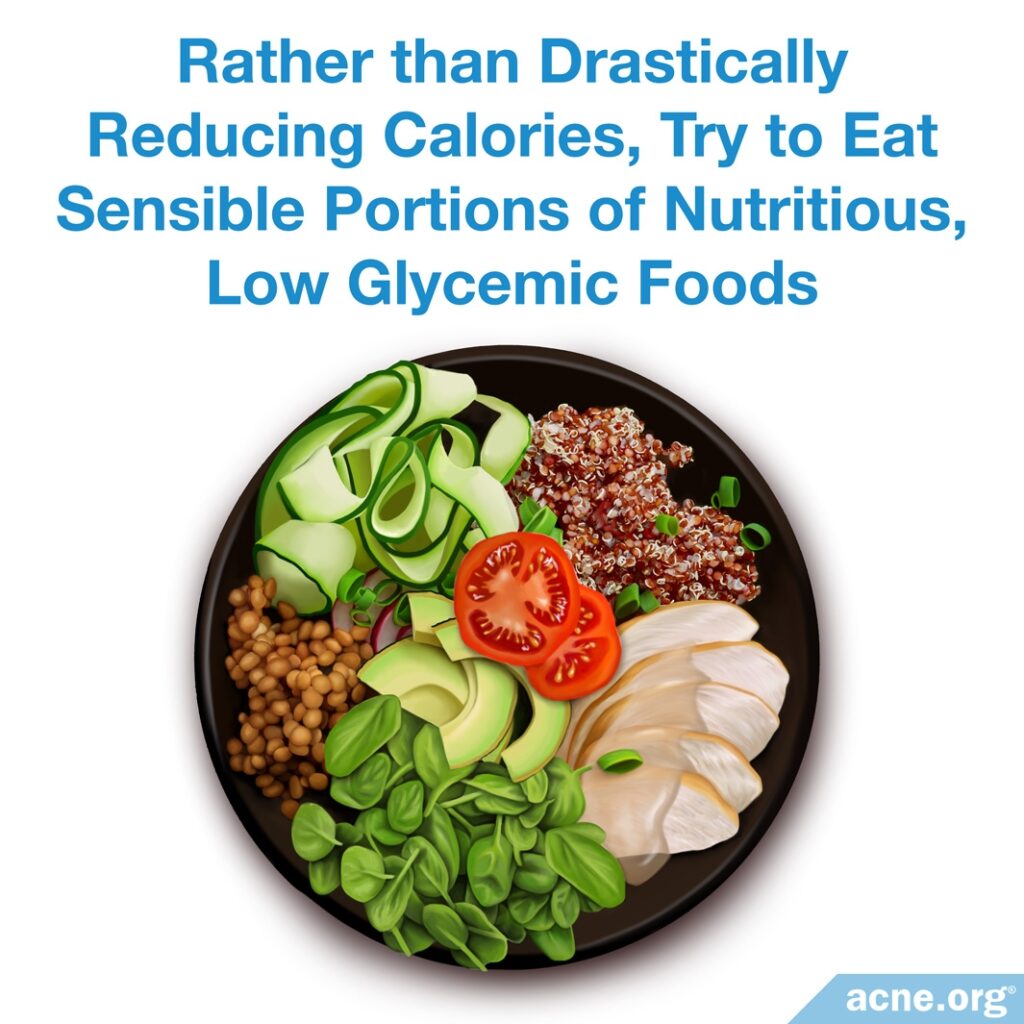
Having said this, if you have a big event coming up that you really want to be clear for, you can try limiting your calories as the event approaches. To be certain your body responds, only do this occasionally–keep it in your back pocket for really big events. If you are like me and can’t deal with eating low calorie, try limiting carbohydrates as the event approaches instead. This is another way to keep insulin levels in check while staying pleasantly full.
References
- Pasiakos SM, Caruso, C. M., Kellogg, M. D., Kramer, F. M. & Lieberman, H. R. Appetite and endocrine regulators of energy balance after 2 days of energy restriction: insulin, leptine, ghrelin, and DHEA-S. Obesity 19, 1124-1130 (2011). https://www.ncbi.nlm.nih.gov/pubmed/21212768
- Henning, P. C. et al. “Effects of acute caloric restriction compared to caloric balance on the temporal response of the IGF-1 system.” Metabolism 62, 179-187 (2013). https://www.ncbi.nlm.nih.gov/pubmed/22906764
- Melnik, B. C. Western diet-induced imbalances of FoxO1 and mTORC1 signaling promote the sebofollicular inflammasomopathy acne vulgaris. Exp. Dermatol. 25, 103-104 (2016). https://onlinelibrary.wiley.com/doi/full/10.1111/exd.12898
- Agamia NF, Abdallah, D. M., Sorour, O., Mourad, B. & Younan, D. N. Skin expression of mammalian target of rapamycin and forkhead box transcription factor O1, and serum insulin-like growth factor-1 in patients with acne vulgaris and their relationship with diet. Br. J. Dermatol. 174, 1299-1307 (2016). https://www.ncbi.nlm.nih.gov/pubmed/26799159
- González-Mondragón, E.A., et al. Acne and diet: a review of pathogenic mechanisms. Acné y dieta: una revisión de los mecanismos patogénicos. Boletin medico del Hospital Infantil de México 79, 83-90 (2022). https://pubmed.ncbi.nlm.nih.gov/35468121/
- Pochi, P. E., Downing, D. T. & Strauss, J. S. Sebaceous gland response in man to prolonged total caloric deprivation. J. Invest. Dermatol. 55, 303-309 (1970). https://www.ncbi.nlm.nih.gov/pubmed/5483834
- Downing, D. T., Strauss, J. S. & Pochi, P. E. Changes in skin surface lipid composition induced by severe caloric restriction in man. Am. J. Clin. Nutr. 25, 365-367 (1972). https://www.ncbi.nlm.nih.gov/pubmed/5010536
- Darlenski, R., et al. The link between obesity and the skin. Frontiers in Nutrition 9, 1-7 (2022). https://pubmed.ncbi.nlm.nih.gov/35369048/
- Kucharska, A., et al. Significance of diet in treated and untreated acne vulgaris. Postepy dermatologii i alergologii 33, 81-86 (2016). https://pubmed.ncbi.nlm.nih.gov/27279815/
- Kwon, H. H., Yoon, J. Y., Hong, J. S., Jung, J. Y., Park, M. S. & Suh, D. H. Clinical and histological effect of a low glycaemic load diet in treatment of acne vulgaris in Korean patients: a randomized, controlled trial. Acta Derm. Venereol. 92, 241-246 (2012). https://www.ncbi.nlm.nih.gov/pubmed/22678562
- Burris, J., Shikany, J. M., Rietkerk, W. & Woolf K. A low glycemic index and glycemic load diet decreases insulin-like growth factor-1 among adults with moderate and severe acne: A short-duration, 2-week randomized controlled trial. J. Acad. Nutr. Diet. 118, 1874-1885 (2018). https://www.ncbi.nlm.nih.gov/pubmed/29691143
 Acne.org Products
Acne.org Products